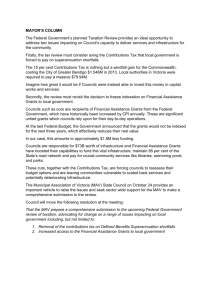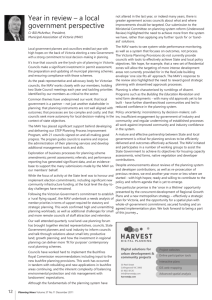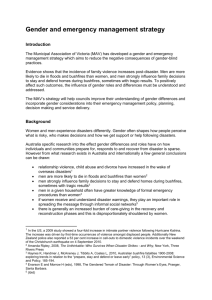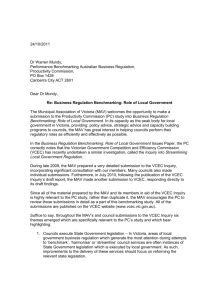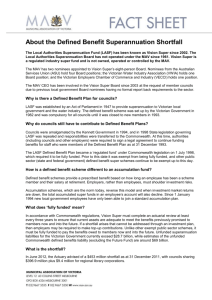Submission to Productivity Commission inquiry into natural disaster
advertisement
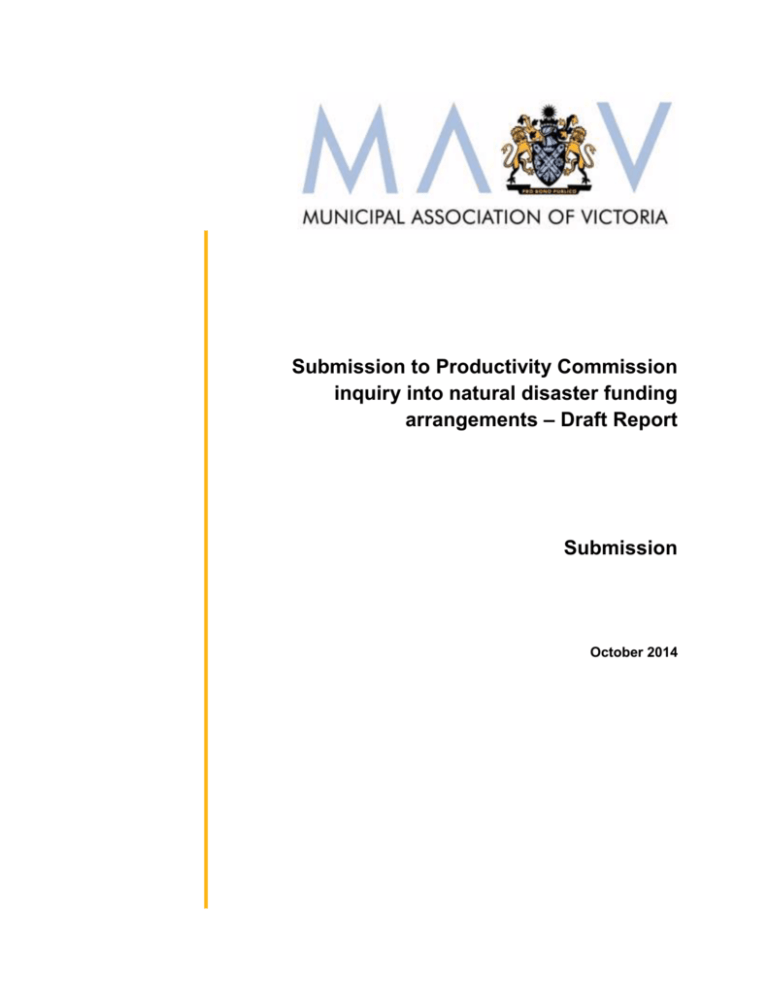
Submission to Productivity Commission inquiry into natural disaster funding arrangements – Draft Report Submission October 2014 © Copyright Municipal Association of Victoria, 2014. The Municipal Association of Victoria is the owner of the copyright in the publication Submission to Productivity Commission inquiry into natural disaster funding arrangements draft report, Oct 2014. No part of this publication may be reproduced, stored or transmitted in any form or by any means without the prior permission in writing from the Municipal Association of Victoria. All requests to reproduce, store or transmit material contained in the publication should be addressed to Martijn Gough on 9667 5540 or mgough@mav.asn.au. The MAV does not guarantee the accuracy of this document's contents if retrieved from sources other than its official websites or directly from a MAV employee. Submission to Productivity Commission inquiry into natural disaster funding arrangements draft report, Oct 2014 Table of contents 1 Executive Summary ............................................................................................................ 4 2 Introduction ......................................................................................................................... 6 3 Productivity Commission draft recommendations ................................................................ 6 4 Productivity Commission information requests ...................................................................17 Submission to Productivity Commission inquiry into natural disaster funding arrangements draft report, Oct 2014 1 Executive Summary The MAV and Victorian councils welcome the opportunity to respond to the Productivity Commission’s draft report on natural disaster funding arrangements (the ‘draft report’). This submission builds on the MAV’s response to the Productivity Commission’s issues paper in which we outlined councils’ role in emergency management, the issues with the current natural disaster funding arrangements and principles for future reform. The MAV is pleased that the draft report has incorporated a number of the concerns Victorian councils have with the current funding arrangements. Specifically the Commission has acknowledged that the prescriptive nature of the current funding arrangements have restricted councils’ ability to spend funding effectively. The MAV supports more autonomy being given to councils to distribute funding efficiently and in line with community priorities. The MAV is concerned that a number of the draft recommendations and the reform options proposed by the Commission will lead to a significant financial burden being placed upon councils that have limited financial capacity to further contribute to natural disaster funding. Increasing the threshold for Commonwealth support from the current ‘small disaster’ threshold of $240,000 to $2 million, asking councils to increase their already significant contribution to mitigation expenditure and reducing the amount the Commonwealth contributes to relief and recovery will place further pressure on council budgets. Councils will also be increasingly reliant on the goodwill of the Victorian State Government under the proposed arrangements. Councils should expect some, if not all, of the reductions in funding to States from the proposed options to flow through to the support they receive. These reform options offer no certainty to councils and communities that they will receive the support they need to manage natural disasters. A key principle outlined in our submission to the Commission’s issues paper was ‘communities should not be disadvantaged by the changes to natural disaster funding arrangements’. Therefore it is disappointing that the Commission provides little rationale for their recommendations substantiated by clear analysis and evidence. The Commonwealth should not accept any of the three proposed options without fully understanding their economic and social consequences. Specifically, the effects of a reduction in funding by the Commonwealth on local or state government budgets and the flow-on effects to other services and programs have not been analysed. Nor is there an analysis of the social effects on communities of the Commission’s recommended reduction in personal, business and primary producer support payments. The Commission proposes that the reform will be implemented over three years. The Commission expects the removal of hardship and clean-up grants and a general reduction in funding overall to provide sufficient incentives for individuals and business to purchase 4 Submission to Productivity Commission inquiry into natural disaster funding arrangements draft report, Oct 2014 appropriate insurance or undertake other resilience measures. However the resolution of information barriers preventing the uptake of insurance and the implementation of resilience measures may take considerably longer than three years, leaving a number of individuals and businesses exposed and vulnerable to natural disasters without an adequate safety net. The effect of a lack of safety net on the ability for a community to recover quickly may be considerable. The Commission’s recommended reductions in funding to the States and therefore councils should also not be viewed in isolation. The 2014-15 Federal Budget decision to freeze indexation of the local government Financial Assistance Grants will cost councils $96m this year, $200m next year and more than $300m the year after. All councils will be affected, however smaller rural and remote councils which depend most on the grants will experience the most hardship. The Commonwealth must accept that its reduction in funding in multiple areas will have a significant cumulative effect on the services councils provide their communities. Overall the reforms proposed by the Commission will leave councils in a vulnerable and uncertain situation where they will rely on the goodwill of state governments to determine how and when support will be distributed. 5 Submission to Productivity Commission inquiry into natural disaster funding arrangements draft report, Oct 2014 2 Introduction The MAV and Victorian councils welcome the opportunity to respond to the Productivity Commission’s draft report on natural disaster funding arrangements. The MAV is pleased that the draft report has incorporated a number of the concerns Victorian councils have with the current funding arrangements. The MAV is concerned that a number of the draft recommendations and the reform options proposed by the Commission will lead to a significant financial burden being placed upon councils that have limited financial capacity to further contribute to natural disaster funding. Given the significant detail and length of the Commission’s draft report and the very limited consultation period, the MAV has focused its response on individual recommendations and a small number of relevant information requests. 3 Productivity Commission draft recommendations 1. DRAFT RECOMMENDATION 3.3 THE AUSTRALIAN GOVERNMENT SHOULD PUBLISH ESTIMATES OF THE FUTURE COSTS OF NATURAL DISASTERS TO ITS BUDGET IN THE STATEMENT OF RISKS. IT SHOULD ALSO PROVISION THROUGH ANNUAL APPROPRIATION FOR SOME BASE LEVEL OF NATURAL DISASTER RISKS THAT CAN BE REASONABLY FORESEEN. FOR MORE CATASTROPHIC, LESS QUANTIFIABLE RISKS, IT IS LIKELY TO BE MORE EFFICIENT TO FINANCE THE RELATED COSTS IF AND WHEN THE RISKS ARE REALISED. The MAV supports reasonably expected risks to be provisioned in Commonwealth Government budgets. This would provide more transparency and therefore make governments more accountable for the decisions they make regarding natural disaster expenditure. This recommendation should be extended to include state governments. 2. DRAFT RECOMMENDATION 3.1 THE AUSTRALIAN GOVERNMENT SHOULD: REDUCE ITS MARGINAL COST SHARING CONTRIBUTION RATE TO DISASTER RECOVERY OUTLAYS TO 50 PER CENT UNDER THE NATURAL DISASTER RELIEF AND RECOVERY ARRANGEMENTS INCREASE THE TRIGGERS FOR AUSTRALIAN GOVERNMENT ASSISTANCE (SMALL DISASTER CRITERION AND ANNUAL EXPENDITURE THRESHOLD). 6 Submission to Productivity Commission inquiry into natural disaster funding arrangements draft report, Oct 2014 IN CONJUNCTION WITH THIS REDUCTION IN FUNDING ASSISTANCE, THE AUSTRALIAN GOVERNMENT SHOULD PROVIDE STATE AND TERRITORY GOVERNMENTS WITH INCREASED AUTONOMY TO MANAGE RELIEF AND RECOVERY EXPENDITURE IN A WAY THAT REFLECTS THE PREFERENCES AND CHARACTERISTICS OF THEIR COMMUNITIES. The MAV does not support a reduction in the Commonwealth marginal cost sharing contribution rate to 50 per cent or changes to the small disaster criterion and annual expenditure threshold without further analysis of the financial and social effect of this reform on councils and their communities. The MAV appreciates that this recommendation is directed towards state governments. The Commission also notes that ‘Each state would continue to have full autonomy on how it provides support to its local governments’ (page 19). Whilst the Commission has not undertaken any analysis of how this reform will affect State government budgets, it is likely to be significant. Therefore councils should expect some, if not all, of the reductions in funding to flow through to the support they receive. This leaves councils in a vulnerable and uncertain situation where they will rely on the goodwill of state governments to determine how and when support will be distributed. The Commission recognises that the Commonwealth has a role in bearing some natural disaster risk due to vertical fiscal imbalance (VFI). The Commission also states that the Commonwealth’s provision of this ‘safety net’ reflects the Australian Government’s greater ability to bear fiscal shocks. However there is no analysis of how the recommended reforms would affect local government budgets which have a limited ability to bear the fiscal shocks of natural disasters. The MAV made clear in its submission to the Commission issues paper that for many councils their capacity to increase the resources they put into emergency management is constrained. A council’s capacity for flexibility regarding how they allocate funding between risk mitigation, relief and recovery is limited by their statutory responsibilities and income streams. The changes to expenditure thresholds and the marginal rate of contribution would likely see limited changes in behaviour by councils in regards to the amount of funding they currently allocate to relief and recovery. Broadly speaking this is due to the inability of many communities to absorb rate increases and the financial position of some councils that would make it difficult to redirect or reprioritise revenue. This would result in a small pool of funding being spread more thinly across mitigation, relief and recovery as well as the current emergency management responsibilities council undertake that are not cost-shared. The implications for communities if such reforms were to be introduced are serious and must remain a key consideration in this reform process. The MAV understands the need to provide improved incentives to help ensure disaster recovery funding is spent efficiently. However the MAV believes that other incentive measures and changes to distortionary policy proposed by the Commission are sufficient to ensure greater efficiency. 7 Submission to Productivity Commission inquiry into natural disaster funding arrangements draft report, Oct 2014 The MAV does not support an increase of the triggers for Australian Government assistance (small disaster criterion and annual expenditure threshold). For many councils $240,000 is a large proportion of their discretionary budget. If an emergency in a council fell just short of this threshold such a budgetary shock would put significant stress on a council and its ability to effectively meet its everyday responsibilities. The increase of the trigger from $240,000 to $2 million would further exacerbate this risk. Indeed the Commission recognises that for state governments the $2 million trigger may be too high in some circumstances The use of an event-based trigger also introduces some challenges. In particular, the trigger may not adequately target a state’s fiscal capacity. For example, a jurisdiction could experience multiple disasters over a short period of time. Where these events are below the threshold for an eligible event the state would not receive any Australian Government assistance. (page 129) Given the Commission notes that the trigger ‘may not adequately target a state’s fiscal capacity’ it should be accepted that this increased trigger will not adequately target a council’s significantly lower fiscal capacity. The MAV is concerned that these recommendations combined - essentially a reduction in funding - will put significant strain on state government budgets. This will likely result in the State decreasing the contribution they currently provide to councils which, as outlined above, have little capacity to increase their own funding. Further, the Commission’s recommended reductions in funding to the states and therefore councils should not be viewed in isolation. The decision in the 2014-15 Federal Budget to freeze indexation of the local government Financial Assistance Grants will cost councils $96m this year, $200m next year and more than $300m the year after. All councils will be affected, however smaller rural and remote councils which depend most on the grants will experience the most hardship. The Financial Assistance Grants, provided each year by the Commonwealth to councils to pay for vital community services and infrastructure, including roads, parks, swimming pools, libraries and childcare, are an important part of the Australia’s Federal system of government, seeking to ensure that all Australians, wherever they live, enjoy a basic standard of local services and infrastructure. The Commonwealth must accept that its reduction in funding in multiple areas will have a significant cumulative effect on the services councils provide their communities. Additionally the Victorian State Labor opposition recently announced its intention to introduce rate capping if it is successful in the November 2014 election. If this were to occur all councils, not just those that are resource constrained, would have limited flexibility to increase the resources put towards natural disaster mitigation, relief and recovery. The MAV supports councils being given increased autonomy to manage relief and recovery expenditure in a way that reflects the preferences and characteristics of their communities. This would alleviate a problem with the current system, which is overly prescriptive and does not allow councils to spend funding efficiently. The Commission articulates this problem astutely in its draft report. 8 Submission to Productivity Commission inquiry into natural disaster funding arrangements draft report, Oct 2014 3. DRAFT RECOMMENDATION 3.2 IF THE AUSTRALIAN GOVERNMENT REDUCES THE RELIEF AND RECOVERY FUNDING IT PROVIDES TO STATE AND TERRITORY GOVERNMENTS, IT SHOULD INCREASE ANNUAL MITIGATION EXPENDITURE GRADUALLY TO $200 MILLION, DISTRIBUTED TO THE STATES AND TERRITORIES ON A PER CAPITA BASIS. THE AMOUNT OF MITIGATION SPENDING COULD BE ADJUSTED OVER TIME TO REFLECT THE IMPUTED ‘SAVINGS’ FROM REDUCED RELIEF AND RECOVERY FUNDING. INCREASED MITIGATION FUNDING SHOULD BE CONDITIONAL ON MATCHED FUNDING CONTRIBUTIONS FROM THE STATES AND TERRITORIES AND BEST-PRACTICE INSTITUTIONAL AND GOVERNANCE ARRANGEMENTS FOR IDENTIFYING AND SELECTING MITIGATION PROJECTS. THESE WOULD INCLUDE: PROJECT PROPOSALS EVALUATIONS THAT (INCLUDING NON-QUANTIFIABLE IMPACTS), ARE SUPPORTED COST–BENEFIT CONSISTENT BY ROBUST ANALYSIS WITH AND NATIONAL AND TRANSPARENT ASSESSMENT EMERGENCY OF RISK ASSESSMENT GUIDELINES RISK ASSESSMENTS AND LONG-TERM ASSET MANAGEMENT PLANS, AND SUBJECT TO PUBLIC CONSULTATION AND PUBLIC DISCLOSURE OF ANALYSIS AND DECISIONS CONSIDERING ALL ALTERNATIVE OR COMPLEMENTARY MITIGATION OPTIONS (INCLUDING BOTH STRUCTURAL AND NON-STRUCTURAL MEASURES) USING PRIVATE FUNDING SOURCES WHERE IT IS FEASIBLE AND EFFICIENT TO DO SO (INCLUDING CHARGING BENEFICIARIES) PARTNERING WITH INSURERS TO ENCOURAGE TAKE-UP OF ADEQUATE PRIVATE INSURANCE AND PRIVATE MITIGATION THROUGH MEASURES SUCH AS IMPROVED INFORMATION SHARING AND REDUCED PREMIUMS The MAV supports an increase in funding being directed towards mitigation. However, as described, councils have limited capacity to further contribute to such expenditure. Requiring councils to contribute more to mitigation projects may mean that some legitimate mitigation projects with positive cost-benefit analysis figures will not go ahead as councils are unable to provide their required contribution. The Commission is also not clear about how cost sharing arrangements would work. Victorian councils agree that mitigation funding should increase however the increase should match the quantum of the Commonwealth decrease in relief and recovery funding. This should occur until the Commonwealth can prove that mitigation and incentive measures put in place are quantifiably reducing the need for relief and recovery funding. The MAV supports increased neutrality and transparency, including robust economic evaluations, when identifying and selecting mitigation projects. 9 Submission to Productivity Commission inquiry into natural disaster funding arrangements draft report, Oct 2014 4. DRAFT RECOMMENDATION 3.6 THE COMMONWEALTH GRANTS COMMISSION SHOULD REVISIT ITS ASSESSMENT OF ‘AVERAGE STATE POLICY’ AND ACCOMPANYING ACCOUNTABILITY REQUIREMENTS FOR NATURAL DISASTER POLICIES ONCE THE AUSTRALIAN GOVERNMENT HAS ANNOUNCED ITS DECISION REGARDING RELIEF AND RECOVERY FUNDING ARRANGEMENTS. The MAV has no comment on this recommendation. 5. DRAFT RECOMMENDATION 3.4 STATE, TERRITORY AND LOCAL GOVERNMENTS SHOULD FURTHER INVESTIGATE NON-TRADITIONAL INSURANCE PRODUCTS FOR ROADS. WHERE THEY DO NOT ALREADY DO SO, STATE, TERRITORY AND LOCAL GOVERNMENTS SHOULD COMPILE AND PUBLISH DETAILED REGISTERS OF ROAD ASSET CONDITION AND MAINTENANCE FOR ALL ROADS OVER WHICH THEY HAVE JURISDICTION (AND HAVE THESE REGISTERS INDEPENDENTLY AUDITED). THIS MAY HELP INSURANCE MARKETS TO UNDERSTAND AND PRICE THE RISK. CONSIDERATION SHOULD BE GIVEN TO THE VICTORIAN MODEL IN THIS REGARD. The MAV conditionally supports this recommendation. Whilst the difficulty in distinguishing maintenance from reconstruction costs may provide some barriers to insurance it is not the main barrier. Non-traditional insurance products are unlikely to provide a solution to the problem of relatively large asset risks in municipalities with low rate bases and therefore insurance premiums that councils cannot afford to pay. Additionally, the type of insurance product does not change the risk profile and the premium to payout ratio insurance companies may be willing to offer. Insurance companies have significant amounts of information on the risks to assets in Australia however they would only be willing to offer a lower premium if the payment against whichever metric was chosen, be it actual assessed damage or some proxy such as rainfall, was commensurately lower. Essentially lower premiums would likely be a result of underinsurance. The Commission acknowledges that a key rationale for Commonwealth contribution to natural disaster funding is because ‘the Australian Government is better able to bear very large or geographically diversified risks because of its broader revenue base’ (page 14). This rationale could be extended to insurance. Many Victorian councils simply do not have the revenue base to support premiums for relatively large road asset risks. For example, Buloke Shire, located in North Western Victoria and with a population of slightly less than one person per square kilometre, had revenue from rates and charges in 2012-2013 of $9.866 million.1 However for the 2010-2011 Victorian floods Buloke Shire has received over $50 million in 1 http://www.dpcd.vic.gov.au/localgovernment/find-your-local-council/buloke 10Submission to Productivity Commission inquiry into natural disaster funding arrangements draft report, Oct 2014 NDRRA funding to undertake repairs and clean-up work. It is very unlikely that Buloke would be able to afford a premium for insurance that would pay such a large claim. More investigation should be undertaken not only into ‘non-traditional insurance’ but insurance schemes at the state or national level that are capable of spreading large and diverse risk over time and space. Many Victorian councils already have some form of asset register for roads and other assets. The requirements for asset registers the Commission is suggesting would require significant resources to compile and audit. Some councils, especially those with large road networks and low rate bases, would require support to compile and maintain such registers. Given that this may be a significant undertaking, more work needs to be completed by the Commonwealth to analyse the effectiveness of such registers in facilitating the uptake of insurance products. Currently the Commission states that such registers ‘may help insurance markets to understand and price the risk’. More certainty of the benefit of this approach is required given the investment needed. 6. DRAFT RECOMMENDATION 3.5 THE AUSTRALIAN GOVERNMENT SHOULD: CEASE REIMBURSEMENT TO STATE AND TERRITORY GOVERNMENTS UNDER THE NATURAL DISASTER RELIEF AND RECOVERY ARRANGEMENTS FOR RELIEF PAYMENTS FOR EMERGENCY FOOD, CLOTHING OR TEMPORARY ACCOMMODATION AND ASSISTANCE TO BUSINESSES AND PRIMARY PRODUCERS (INCLUDING CONCESSIONAL LOANS, SUBSIDIES, GRANTS AND CLEAN-UP AND RECOVERY GRANTS) REDUCE THE AMOUNT PROVIDED UNDER THE AUSTRALIAN GOVERNMENT DISASTER RECOVERY PAYMENT (AGDRP). THE AUSTRALIAN GOVERNMENT CRISIS PAYMENT MAY PROVIDE A REASONABLE BENCHMARK IN THIS REGARD LEGISLATE THE ELIGIBILITY CRITERIA FOR THE AGDRP AND THE DISASTER RECOVERY ALLOWANCE AND MAKE THESE NOT SUBJECT TO MINISTERIAL DISCRETION The MAV does not support the cessation of reimbursement to state and territory governments under the Natural Disaster Relief and Recovery Arrangements for personal hardship assistance and clean-up and recovery grants. In regards to personal hardship assistance, the MAV is concerned that the AGDRP is not consistently applied, targeted or timely in its provision. Therefore abolishing State-based personal assistance may leave a community with poor immediate relief or delayed relief. Anecdotal reports suggest that Commonwealth representatives are not consistently present at relief and recovery centres and that payments are given without needs assessments. 11Submission to Productivity Commission inquiry into natural disaster funding arrangements draft report, Oct 2014 Victorian Personal Hardship Assistance Programs are currently a superior form of assistance that is generally well received by the community and consistently applied across local jurisdictions. Additionally the administration of assistance can help build or strengthen relationships and networks between the Victorian Department of Human Services and local communities and help identify individuals who may need more ongoing assistance. The Commission has stated that the case for supporting businesses and primary producers is ‘weak’ however they provide little evidence to uphold this claim. The Commission has not published any analysis of the effect of support to businesses and primary producers or indeed the effect of removing such support. In their submission to the Commission’s issues paper the Regional Australia Institute (PC Submission 61), identifies a strong link between business recovery and overall community recovery and resilience. When businesses (including primary producers) recover quickly following natural disasters, populations are more likely to return to the area. Clean-up and recovery grants are a relatively low cost form of support and the Commission should undertake further analysis on their effectiveness before recommending their abolition. The MAV is also concerned reforms to Category A assistance under NDRRA will result in the Commonwealth no longer sharing the costs associated with establishing and operating relief and recovery centres. Additionally there is a lack of clarity in the draft report regarding the Commission’s consideration of the continuation of support for ‘counter disaster’ operations under category B of NDRRA. The MAV recommends that counter disaster operations remain funded. There is a strong rationale for these operations, which can include debris removal, livestock disposal and the disposal of hazardous waste, being coordinated and collectively provided at a community wide level. Such action protects the general public and ensures health and safety measures are restored quickly. The Commission proposes that the reform will be implemented over three years. The Commission expects the removal of hardship and clean-up grants and a general reduction in funding overall to provide sufficient incentives for individuals and business to purchase appropriate insurance or undertake other resilience measures. However the resolution of information barriers preventing the uptake of insurance and the implementation of resilience measures may take considerably longer than three years, leaving a number of individuals and businesses exposed and vulnerable to natural disasters without an adequate safety net. The effect of a lack of safety net on the ability for a community to recover quickly may be considerable. 1. DRAFT RECOMMENDATION 4.1 WHEN COLLECTING NEW NATURAL HAZARD DATA OR UNDERTAKING MODELLING, ALL LEVELS OF GOVERNMENTS SHOULD: 12Submission to Productivity Commission inquiry into natural disaster funding arrangements draft report, Oct 2014 MAKE INFORMATION PUBLICLY AVAILABLE WHERE IT IS USED FOR THEIR OWN RISK MANAGEMENT AND/OR THERE ARE SIGNIFICANT PUBLIC BENEFITS FROM DOING SO USE PRIVATE SECTOR PROVIDERS WHERE COST EFFECTIVE, AND USE LICENCING ARRANGEMENTS THAT ALLOW FOR PUBLIC DISSEMINATION. WHERE THERE ARE COSTS INVOLVED IN OBTAINING INTELLECTUAL PROPERTY RIGHTS FOR EXISTING DATA, GOVERNMENTS SHOULD WEIGH UP THESE COSTS AGAINST THE PUBLIC BENEFITS OF MAKING THE DATA FREELY ACCESSIBLE APPLY COST RECOVERY WHERE GOVERNMENTS ARE BEST PLACED TO COLLECT OR ANALYSE SPECIALIST DATA FOR WHICH THE BENEFITS ACCRUE MOSTLY TO PRIVATE SECTOR USERS. The MAV conditionally supports this recommendation. Before making information relating to hazards and risks publicly available councils would need to be assured of the legal liability that flows from such action. The MAV notes recommendation 4.6 recognises this issue. 2. DRAFT RECOMMENDATION 4.2 STATE AND TERRITORY GOVERNMENTS, LOCAL GOVERNMENTS AND INSURERS SHOULD EXPLORE OPPORTUNITIES FOR COLLABORATION AND PARTNERSHIPS. PARTNERSHIPS, FOR EXAMPLE, COULD BE FORMED THROUGH THE INSURANCE COUNCIL OF AUSTRALIA AND STATE-BASED LOCAL GOVERNMENT ASSOCIATIONS (OR REGIONAL ORGANISATIONS OF COUNCILS). CONSIDERATION COULD BE GIVEN TO THE TRUSTED INFORMATION SHARING NETWORK MODEL, AND INVOLVE: GOVERNMENTS SHARING NATURAL HAZARD DATA THAT THEY ALREADY HOLD AND UNDERTAKING LAND USE PLANNING AND MITIGATION TO REDUCE RISK EXPOSURE AND VULNERABILITY INSURERS SHARING EXPERTISE AND INFORMATION (FOR EXAMPLE, CLAIMS DATA) TO INFORM LAND USE PLANNING AND MITIGATION COLLABORATION TO INFORM HOUSEHOLDS OF THE RISKS THAT THEY FACE AND ADEQUACY OF THEIR INSURANCE TO FULLY COVER REBUILDING COSTS, AND TO ENCOURAGE PRIVATE FUNDING OF MITIGATION THROUGH INCENTIVES SUCH AS REDUCED PREMIUMS. The MAV supports collaboration and information sharing between all relevant sectors. 13Submission to Productivity Commission inquiry into natural disaster funding arrangements draft report, Oct 2014 3. DRAFT RECOMMENDATION 4.3 STATE AND TERRITORY GOVERNMENTS SHOULD HASTEN IMPLEMENTATION OF THE ENHANCING DISASTER RESILIENCE IN THE BUILT ENVIRONMENT ROADMAP, INCLUDING REVIEWING THE REGULATORY COMPONENTS OF VENDOR DISCLOSURE STATEMENTS. FURTHERMORE, THE LAND USE PLANNING AND BUILDING CODES TASKFORCE SHOULD CONSIDER POSSIBILITIES FOR REGULAR, LOW-COST DISSEMINATION OF HAZARD INFORMATION TO HOUSEHOLDS BY GOVERNMENTS AND INSURERS (FOR EXAMPLE, THE WORK OF THE INSURANCE COUNCIL OF AUSTRALIA TO DEVELOP NATURAL HAZARD RATINGS AT A HOUSEHOLD LEVEL). The MAV supports vendor disclosure as a critical component of the natural hazards risk management process. However it is important to ensure that achieving disclosure requirements is not overly burdensome. 4. DRAFT RECOMMENDATION 4.4 STATE GOVERNMENTS SHOULD: CLEARLY ARTICULATE THE STATEWIDE NATURAL HAZARD RISK APPETITE IN LAND USE PLANNING POLICY FRAMEWORKS PROVIDE LOCAL GOVERNMENTS WITH GUIDANCE ON HOW TO PRIORITISE COMPETING OBJECTIVES WITHIN LAND USE PLANNING PROVIDE LOCAL GOVERNMENT WITH GUIDANCE ON HOW TO INTEGRATE LAND USE PLANNING AND BUILDING STANDARDS. CONSIDERATION SHOULD BE GIVEN TO VICTORIA’S INTEGRATED PLANNING AND BUILDING FRAMEWORK FOR BUSHFIRE IN THIS REGARD. FURTHERMORE, LOCAL GOVERNMENTS SHOULD PUBLISH THE REASONING BEHIND DEVELOPMENT ASSESSMENT DECISIONS. The MAV supports this recommendation and the identified need for strong State Government leadership when articulating hazard risk appetite and providing guidance on how to prioritise competing objectives. The Victorian Government has made progress in this regard, specifically in relation to bushfire. Monitoring is required by State Government to ensure that reform over time does not weaken the intent of planning controls. The Commission has correctly identified that while land use planning and building regulations are important tools, they have limited reach and effect in existing settlements in the short-term. A broader emergency management response is required to mitigate risk. Often this is lacking. The MAV is of the view that a major barrier to meaningful progress being made in land use planning relating to adaptation and disaster risk reduction is the lack of clarity surrounding infrastructure funding arrangements. 14Submission to Productivity Commission inquiry into natural disaster funding arrangements draft report, Oct 2014 5. DRAFT RECOMMENDATION 4.5 THE ONUS IS ON STATE GOVERNMENTS TO ENSURE THAT LOCAL GOVERNMENTS IN THEIR JURISDICTION ARE SUFFICIENTLY RESOURCED TO EFFECTIVELY IMPLEMENT THEIR LAND USE PLANNING RESPONSIBILITIES. STATE GOVERNMENTS SHOULD REVIEW THE ADEQUACY OF LOCAL GOVERNMENTS’ RESOURCES AND CAPABILITIES, AND PROVIDE FURTHER RESOURCES AND SUPPORT WHERE THEY ARE NOT ADEQUATE. The MAV supports further resources being provided to councils to assist them to exercise their land use planning obligations effectively. As found previously by the Commission in their Barriers to Effective Climate Change Adaptation Inquiry Report, the MAV agrees that the capacity and capability constraints of local government are barriers to land use planning and building system reaching its full potential. 6. DRAFT RECOMMENDATION 4.6 STATE GOVERNMENTS SHOULD PROVIDE ADDITIONAL SUPPORT AND GUIDANCE TO LOCAL GOVERNMENTS THAT ADDRESSES THE EXTENT OF LOCAL GOVERNMENTS’ LEGAL LIABILITY WHEN RELEASING NATURAL HAZARD INFORMATION AND MAKING CHANGES TO LAND USE PLANNING REGULATIONS. The MAV supports additional guidance being provided to local government regarding legal liability. However, the Commission should expand this recommendation to include the protection of councils from common law liability where planning decisions are consistent with State planning rules (in Victoria the Victoria Planning Provisions) and associated guidance material. 7. DRAFT RECOMMENDATION 4.7 THE PROVISIONS IN THE QUEENSLAND SUSTAINABLE PLANNING ACT 2009 FOR INJURIOUS AFFECTION SHOULD BE REPEALED. The MAV has no comment on this recommendation. 8. DRAFT RECOMMENDATION 4.10 ALL GOVERNMENTS SHOULD PUT IN PLACE BEST-PRACTICE INSTITUTIONAL AND GOVERNANCE ARRANGEMENTS FOR THE PROVISION OF PUBLIC INFRASTRUCTURE, INCLUDING ROAD INFRASTRUCTURE. THESE SHOULD INCLUDE: 15Submission to Productivity Commission inquiry into natural disaster funding arrangements draft report, Oct 2014 STRONGER PROCESSES FOR PROJECT SELECTION THAT INCORPORATE REQUIREMENTS FOR COST–BENEFIT ANALYSES THAT ARE INDEPENDENTLY SCRUTINISED AND PUBLICLY RELEASED CONSIDERATION OF NATURAL DISASTER RISK IN PROJECT SELECTION A CLEARER LINK BETWEEN ROAD-USER PREFERENCES AND MAINTENANCE AND INVESTMENT DECISIONS. The MAV supports appropriate and proportionate governance and decision-making frameworks for the provision of public infrastructure. On page 185 of the draft report the Commission also states: Road Funds should be established by state governments that would enable roads investments to be considered on a portfolio-wide basis with projects with the highest net benefit to the community being selected. An approach based on absolute net benefit dollar figures could possibly lead to few projects being approved in rural and regional areas. Approaches that would allow for continued State investment in rural and regional areas must also be considered. For example cost-benefit ratios may be more appropriate. 9. DRAFT RECOMMENDATION 4.8 STATE AND TERRITORY TAXES AND LEVIES ON GENERAL INSURANCE SHOULD BE PHASED OUT AND REPLACED WITH LESS DISTORTIONARY TAXES. The MAV supports this recommendation. 10. DRAFT RECOMMENDATION 4.9 INSURERS SHOULD PROVIDE ADDITIONAL INFORMATION TO HOUSEHOLDS REGARDING THEIR INSURANCE POLICIES, THE NATURAL HAZARDS THEY FACE AND POSSIBLE COSTS OF REBUILDING AFTER A NATURAL DISASTER. THIS WORK COULD BE LED BY THE INSURANCE COUNCIL OF AUSTRALIA TO ENSURE CONSISTENCY IN THE PROVISION OF INFORMATION ACROSS INSURERS. The MAV supports this recommendation. 16Submission to Productivity Commission inquiry into natural disaster funding arrangements draft report, Oct 2014 4 Productivity Commission information requests DO STATE, TERRITORY AND LOCAL GOVERNMENTS MAINTAIN UP-TO-DATE ASSET REGISTERS? The Victorian Auditor General requires Victorian councils to maintain accurate asset registers, and to report on the 'fair value' of assets on an annual basis. Many councils also maintain a centralised asset database using a range of software platforms. Data is kept current through regular inspection of assets and subsequent updating of knowledge about the assets in the database. Regular data integrity checking is carried out to ensure that redundant data is removed. HOW IS ASSET MANAGEMENT PLANNING INTEGRATED INTO STATE, TERRITORY AND LOCAL GOVERNMENT BUDGETS? Asset management knowledge relating to asset lifecycles and asset condition allows a reasonable projection of when assets will reach the end of their life cycles. This allows forecasting of future asset renewal demand by modelling the future change in condition of assets and predicting required funding levels to renew the assets. The results of this modelling work are generally incorporated into a council’s longer term capital and asset planning (generally 10-20 years) and four year capital works plan/program. Councils generally adopt a four year indicative capital works program, where projects beyond the first year are subject to review each year. These strategic planning documents are used to frame annual budgets, aiming to keep within the bounds established by the strategic plans. Any lack of council capacity to fully meet the expected asset renewal demand in any given year is known as the “renewal gap”. HOW DO STATE, TERRITORY AND LOCAL GOVERNMENTS’ ASSET MANAGEMENT PLANS INCORPORATE NATURAL DISASTER RISK MANAGEMENT? All councils’ asset plans incorporate risk assessments and risk management plans, however not all plans incorporate natural disaster risk specifically. Risk management plans are often quite general in nature. However some asset management plans incorporate natural disaster risk management impact assessments for each asset group. TO WHAT EXTENT DO COUNCILS UTILISE DAY LABOUR AND OWN EQUIPMENT FOR COMMUNITY RECOVERY ACTIVITIES, SUCH AS COUNTER DISASTER OPERATIONS? Councils utilise day labour force extensively for community recovery activities. Councils also utilise external assistance from community organisations and volunteers. Councils may seek the support of other councils through the MAV resource sharing protocol, especially where more specialised or longer-term assistance is required. Some examples of the type of work councils undertake include debris removal, water replenishment, arborist assessments, disposal of dead stock and post impact assessments. 17Submission to Productivity Commission inquiry into natural disaster funding arrangements draft report, Oct 2014

